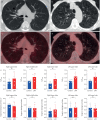The utility of gallium-68 DOTATOC PET/CT in lymphangioleiomyomatosis
- PMID: 34708113
- PMCID: PMC8542959
- DOI: 10.1183/23120541.00397-2021
The utility of gallium-68 DOTATOC PET/CT in lymphangioleiomyomatosis
Abstract
Somatostatin receptor functional imaging is of limited utility as an imaging biomarker in LAM, but other PET/CT modalities may be of use https://bit.ly/3l6BVZp.
Copyright ©The authors 2021.
Figures

References
-
- Young LR, Lee HS, Inoue Y, et al. . Serum VEGF-D concentration as a biomarker of lymphangioleiomyomatosis severity and treatment response: a prospective analysis of the Multicenter International Lymphangioleiomyomatosis Efficacy of Sirolimus (MILES) trial. Lancet Respir Med 2013: 1: 445–452. doi:10.1016/S2213-2600(13)70090-0 - DOI - PMC - PubMed
LinkOut - more resources
Full Text Sources
